
- "On the Road · 2018: Nomination Exhibition for Chinese Young Artists' Works and Youth Critics Forum"
-

Click to view Exhibition Name: On the Road · 2018: Nomination Exhibition for Chinese Young Artists and Youth Critics Forum
Exhibition location: First floor of Shenzhen Guan Shanyue Art Museum
Exhibition period: December 1st to December 20th, 2018
Opening time: December 1st, 2018 15:00
Forum time: December 2, 2018 All day
Forum theme: Unmanned: People and Future Art
Forum location: Conference Room on the Third Floor of Guan Shanyue Art Museum
Organizer: Shenzhen Guan Shanyue Art Museum
Curatorial Committee of China Artists Association
Special Fund for the Development of Propaganda and Culture in Shenzhen
Section 1: Freedom
Ease is a state of silence, neither involving strong subjectivity nor deliberately removing the avoidance behavior of the subject, but approaching the subconscious state of surrealism. Both human and subjectivity are lost due to self dissolution, leaving only the subconscious to diffuse. In Taoism, "ease" is natural, while in Buddhism, "ease" refers to the awakening and enlightenment of oneself. In the era of intelligent tools, while enjoying the fruits of high technology, people also try to reflect on its complex impact, especially on human beings
The influence of "ease". In this brand new future, can humans still define, exist, and realize themselves?
Exhibiting artists: Wang Mi, Liu Jiayu, Shen Linghao, Luo Wei, Liang Ban
Section 2: Questioning and Reflection
Reflection means self reflection. But in the social environment, it often does not refer to the complete self view in religion, but is closely related to the changing natural environment, daily life, and material conditions around us, and sometimes even serves as a channel and intermediary for human/individual introspection. People use and enjoy technology, but are also trapped by it. Conversely, may material and technological factors themselves be the key to unraveling the knot? Is this relationship between humans themselves and technology as artificial beings harmonious coexistence, or will it eventually rupture and lead to confrontation? Humanistic artistic thinking and creation may provide hints.
Exhibiting artists: Group 01 (Liang Lianxi, Chen Rongbin), Yu Yu, Wang Enlai, Lu Shan, Tian Xiaolei, Liu Ying, Li Linlin, Zhang Xiaoying, Chen Baoyang, Lin Xin, Jin Jiangbo, Zhou Changyong, Xu Ziwei, Hai Xiaolong, Dong Dawei, Zeng Jianhua
Section 3: Unmanned
Nietzsche prophesied the death of God, while Roland Barthes asserted the death of the author. Will "no one" be the next constant state? Not only in the reality of logistics, manufacturing, services, transportation and other fields and industries, but also in the intellectual and spiritual world, the "humanism" since the Renaissance may also disappear in the future, creating new forms of civilization and cultural types. However, there are also numerous dissenters. For the absolute sense of no one, positivists believe that behind "no one", there will always be "people", while centrists believe that "no one" will ultimately be the unity of human and non-human.
Exhibiting artists: Mannifold group, Deng Yuejun, Lao Jiahui, Lin Miaoling, Cai Yuxiao, Ma Zhengyang+Yuri Kuzmin、 Guo Ruiwen and Cao Yuxi
The Chinese New Art Movement has been going on for over 30 years now. Over the past 30 years, with the transformation of the economic and cultural environment on which art relies for survival, artistic concepts and forms have also undergone changes. From a historical perspective, these 30 years precisely reflect the process of the self-discipline of contemporary Chinese art and the continuous competition of various factors beyond art. This special era has given birth to extraordinary contemporary Chinese art. Some people say that the era of contemporary art creating myths has passed, implying that art should return to its true order. However, 30 years of crowded ideological trends and noisy concepts are enveloped by various artistic events, just like Kiecher's "Mirror House". Only with a direct blow to oneself can one break the illusion and return to the real world. The post-70s and post-80s generations are the generation of artists who grew up in this "mirror house". Their artistic creations are a turning point for the return of contemporary Chinese art from the "big era" to the "small era", and "on the road" is not only their collective memory of youth, but also the core of their outlook on life and values. As presented in their creations, "on the road" is not only a state, but also an attitude!
The concepts of "post-70s" and "post-80s" first appeared in the poetry industry and have since sparked widespread debate throughout the literary world. They have given extensive attention to the pioneering role of the "post-70s" and "post-80s" writing groups and their fleeting cultural motivations, as well as how "intergenerational logic" emerged and dissipated. Although there was no similar phenomenon of the "post-70s" and "post-80s" groups in the art industry during the same period, the transitional differences between the "post-70s" and "post-80s" creative groups and their predecessors in terms of survival status, knowledge structure, academic background, and creative status are self-evident. A new art ecology that reflects their attitude towards life, aesthetic concepts, and academic direction has quietly formed. Of course, the novelty of the new art ecosystem cannot be denied for its continuation and continuation of tradition, especially the academic context and rules formed since 1985. So, what kind of concept, form, and ecology does the new art ecology present? Where is the new manifestation of new art? What is the turning point of its significance in the development of contemporary art? This is the topic that we intend to focus on and discuss in our series of academic activities.
It should be noted that the presentation of art is certainly related to an era, and artists in the same period must have certain similarities in cultural attention and work presentation. However, artistic creation, especially in the contemporary context, is more about the individual's inner self and endowment. Therefore, it is difficult and impossible for us to make a unified value judgment for a generation with a concept first holistic thinking. Instead, we must connect individuals with node significance through the chain of history to achieve a sensory and objective presentation. At the same time, historical writing without a certain examination distance is inevitably not objective enough. Therefore, although this series of academic activities is aimed at accumulating historical knowledge, it is not dedicated to drawing any historical conclusions. Instead, it strives to present vivid artistic problems in the current comparative collection from the perspective of experienced individuals, and provide certain clues for the writing of art history through the analysis and interpretation of problems. So compared to the many avant-garde biennials and biennials, this series of academic activities emphasizes more on the documentary nature of the content. I hope this series of activities is not only a process of historical review and artistic presentation, but also a process of knowledge production.
In 2018, we will end our field research from a media perspective and embark on the second season of the "On the Road" series of academic activities. Starting from academic issues themselves, we will use hot topics in contemporary theory as clues to organize contemporary art literature. This academic event focuses on the changes brought about by current social development to human survival, as well as the relationship between these changes and future art, and their expression in art, with the keyword "unmanned".
The history of art development is also the history of productivity development, and the changes in production relations caused by productivity development have given rise to different forms of art. Just as the Second Industrial Revolution and the Second Urbanization Wave changed the order of human society and brought modern art to the surface; The third industrial revolution and the Internet plus have made contemporary art emerge from the cocoon. The arrival of the fourth industrial revolution and the era of artificial intelligence will once again have a great impact on human intelligence, living conditions and lifestyles. In the Unmanned era, what changes are taking place in the ecology of art and the state of artists, and what new states will emerge in the foreseeable future?
After World War I, the progress of technology, civilization, and the loss of religion brought about a sense of alienation to people, which led to the emergence of existentialism, which went beyond the scope of pure philosophy and affected all aspects of spiritual life in Western society. Its influence in literature and art was particularly prominent. Existentialism, with a human centered approach and respect for human personality and freedom, has sparked a wave of literature and art primarily focused on psychoanalysis. So in the Unmanned era, under what theoretical support, under what era background, will art present a new appearance?
These will be the issues that this year's "on the road" will focus on and discuss.
The series of academic activities have received support from numerous experts and academic institutions. We would like to express our heartfelt gratitude to the experts, nomination institutions, and partners in various fields who have worked hard for this event!
-
2019-01-07



